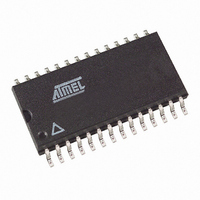AT89C5131-TISIL Atmel, AT89C5131-TISIL Datasheet - Page 89

AT89C5131-TISIL
Manufacturer Part Number
AT89C5131-TISIL
Description
IC 8051 MCU FLASH 32K USB 28SOIC
Manufacturer
Atmel
Series
AT89C513xr
Datasheet
1.AT89C5131-S3SIL.pdf
(176 pages)
Specifications of AT89C5131-TISIL
Core Processor
C52X2
Core Size
8-Bit
Speed
48MHz
Connectivity
I²C, SPI, UART/USART, USB
Peripherals
LED, POR, PWM, WDT
Number Of I /o
18
Program Memory Size
32KB (32K x 8)
Program Memory Type
FLASH
Eeprom Size
4K x 8
Ram Size
1.25K x 8
Voltage - Supply (vcc/vdd)
3 V ~ 3.6 V
Oscillator Type
Internal
Operating Temperature
-40°C ~ 85°C
Package / Case
28-SOIC (7.5mm Width)
For Use With
AT89STK-10 - KIT EVAL APPL MASS STORAGEAT89STK-05 - KIT STARTER FOR AT89C5131
Lead Free Status / RoHS Status
Contains lead / RoHS non-compliant
Data Converters
-
- Current page: 89 of 176
- Download datasheet (3Mb)
Serial Peripheral
Interface (SPI)
Features
Signal Description
Master Output Slave Input
(MOSI)
Master Input Slave Output
(MISO)
SPI Serial Clock (SCK)
Slave Select (SS)
4136B–USB–09/03
The Serial Peripheral Interface module (SPI) allows full-duplex, synchronous, serial
communication between the MCU and peripheral devices, including other MCUs.
Features of the SPI module include the following:
•
•
•
•
•
•
Figure 39 shows a typical SPI bus configuration using one Master controller and many
Slave peripherals. The bus is made of three wires connecting all the devices:
Figure 39. SPI Master/Slaves Interconnection
The Master device selects the individual Slave devices by using four pins of a parallel
port to control the four SS pins of the Slave devices.
This 1-bit signal is directly connected between the Master Device and a Slave Device.
The MOSI line is used to transfer data in series from the Master to the Slave. Therefore,
it is an output signal from the Master, and an input signal to a Slave. A byte (8-bit word)
is transmitted most significant bit (MSB) first, least significant bit (LSB) last.
This 1-bit signal is directly connected between the Slave Device and a Master Device.
The MISO line is used to transfer data in series from the Slave to the Master. Therefore,
it is an output signal from the Slave, and an input signal to the Master. A byte (8-bit
word) is transmitted most significant bit (MSB) first, least significant bit (LSB) last.
This signal is used to synchronize the data movement both in and out the devices
through their MOSI and MISO lines. It is driven by the Master for eight clock cycles
which allows to exchange one byte on the serial lines.
Each Slave peripheral is selected by one Slave Select pin (SS). This signal must stay
low for any message for a Slave. It is obvious that only one Master (SS high level) can
drive the network. The Master may select each Slave device by software through port
Full-duplex, three-wire synchronous transfers
Master or Slave operation
Eight programmable Master clock rates
Serial clock with programmable polarity and phase
Master mode fault error flag with MCU interrupt capability
Write collision flag protection
Master
Slave 4
MISO
MOSI
SCK
SS
0
1
2
3
VDD
Slave 3
Slave 1
Slave 2
AT89C5131
89
Related parts for AT89C5131-TISIL
Image
Part Number
Description
Manufacturer
Datasheet
Request
R

Part Number:
Description:
8-bit Flash Microcontroller With Full Speed Usb Device At89c5131
Manufacturer:
ATMEL Corporation
Datasheet:

Part Number:
Description:
IC 8051 MCU FLASH 32K USB 52PLCC
Manufacturer:
Atmel
Datasheet:

Part Number:
Description:
8-bit Flash Microcontroller with Full Speed USB Device
Manufacturer:
ATMEL Corporation
Datasheet:

Part Number:
Description:
KIT STARTER FOR AT89C5131
Manufacturer:
Atmel
Datasheet:

Part Number:
Description:
IC 8051 MCU FLASH 32K USB 48QFN
Manufacturer:
Atmel
Datasheet:

Part Number:
Description:
IC 8051 MCU FLASH 32K USB 64VQFP
Manufacturer:
Atmel
Datasheet:

Part Number:
Description:
DEV KIT FOR AVR/AVR32
Manufacturer:
Atmel
Datasheet:

Part Number:
Description:
INTERVAL AND WIPE/WASH WIPER CONTROL IC WITH DELAY
Manufacturer:
ATMEL Corporation
Datasheet:

Part Number:
Description:
Low-Voltage Voice-Switched IC for Hands-Free Operation
Manufacturer:
ATMEL Corporation
Datasheet:

Part Number:
Description:
MONOLITHIC INTEGRATED FEATUREPHONE CIRCUIT
Manufacturer:
ATMEL Corporation
Datasheet:

Part Number:
Description:
AM-FM Receiver IC U4255BM-M
Manufacturer:
ATMEL Corporation
Datasheet:

Part Number:
Description:
Monolithic Integrated Feature Phone Circuit
Manufacturer:
ATMEL Corporation
Datasheet:

Part Number:
Description:
Multistandard Video-IF and Quasi Parallel Sound Processing
Manufacturer:
ATMEL Corporation
Datasheet:










